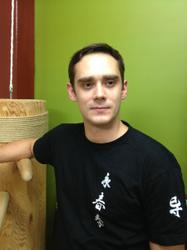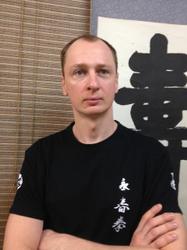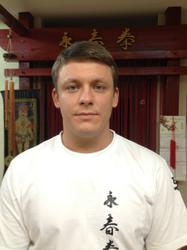Kung Fu, Part 1
INTRODUCTION
To begin with, before you read the following notes, we would like to talk a little bit about the definition of the words KUNG-FU’. A Chinese hieroglyph, it means this is like a human, an artist. A human: an orderer and executer if his own I’. A person who doesn't act within the standard frame of combat conduct. He works spontaneously, depending on the conditions which develop during combat. So the term Kung-fu is a very loose concept. A Chinaman looking at a beautiful picture may remark ''What a beautiful Kung-Fu!'' A good poem may also attract the same comment. This means that KUNG-FU is not only a skill of fighting and ruining everything: rather it is a way of life. KUNG-FU can be learned all through life, discovering inside one's own world. And when you are on the right track, you discover inside yourself new talents and abilities. You start writing poems, music, draw pictures. Just as all the great martial arts Masters were engaged not only in fighting, they also had a high level of aesthetic development. The correct study of martial arts results, not in cruelty and murder (downward direction) but, rather, in an opposite direction, leading one higher and higher to the top of the GUN-FU Mastership. In addition you will learn, not only the secrets of combat conduct, but life’s secrets too. Remember to consider your health as you will always be in excellent shape. Forget about illness and a bad mood, as these classes give you a new vigour, great health and strength for many years.
So start doing KUNG-FU! It is never too late! Of course it is better to become engaged at a younger age in order to have enough time to reach the top. This is because life is too short. Do not be upset, however, if you cannot reach the top. This is not for everyone but there is nothing more important then your health and good shape.
These notes represent what I have selected from ancient writings and the great literature on Eastern martial arts. In my view, they contain all that is necessary to start your KUNG-FU classes. You will see, therefore, a great deal of philosophy. This is not accidental as, without it, it is not possible to bear witness to the truth.
THE TEN COMMANDMENTS
Do not drink wine, do not eat meat, supress the sexual desires, do not become distracted to incidental things, respect your Master and your older students. Do not allow lies in relations, do not brag with your knowledge and demonstrate or apply your art for self-defence only. By any means you should avoid fighting. Do not teach unworthy people. This is the shuttle tactic’ – strike like thunder, dissappear like the wind. Tsyao Yuan lent approval to an approach in Kung-Fu fighting combat tactics as a way for the small to defeat the great. Tsyao Yuan combined the techniques of the Tiger, Dragon, Snake, Leopard and Crane schools. Based on Tsyao Yuan's commandments, the FIVE QUALITIES OF A WARRIOR were designed.
FIVE QUALITIES OF A WARRIOR
- DELICACY – the ability to sense’ the opponent, to predict his behaviour in order to design the optimum reaction.
- STRAIGHTFORWARDNESS – consecutive and steady execution of your chosen action, without looking back at possible defeat.
- PASSIVITY – in all conditions you must maintain a spiritual balance, find the ability to react, not only to your opponent's separate actions, but to see him as a single whole, evaluating his martial abilities.
- GRACEFULLNESS – the ability to move and act in battle conditions with the least amount of energy expended.
- COMBINING THINKING – the ability to chose optimum moves of all types of complexity, the ability to adapt from one system to another. This is especially important when fighting with several opponents at the same time.
JIN LEK ENERGY
Jin Lek describes a phsycological, rather than a physical, phenomenon which demands exceptional concentration. Only mastering this internal energy enables you to conduct impossible acts, and at the same time not forgetting about the individual's athletic abilities. Jin Lek is only accessible to the real Masters and continues to work even when physical abilities leave their bodies due to age. Such people are able to stop an opponent from a distance.
ENERGY CONCENTRATION – it is not enough to be able to create a surge of strength for yourself, which would be able to destroy everything. You have to be able to direct this strength correctly. This depends on the right muscular coordination. Energy concentration also means concentration in time (movement speed) and in space (ending the stroke and maintaining the strength at certain points and limiting them using natural body parts and reaction strengths).
ENERGY TRANSMISSION – all the strength of a strike concentrated in the hand or the foot, when directed at the opponent, has to hit him in the aimed place, as if it was thrown with the equivalent strength of a catapulted mass, whose kinetic energy suddenly stops, transforming it into the destructive action of an impact wave. This very short but effective touch is achieved through concentrated self mobilization of ones body powers and mind concentration. This moment is often accompanied by a short, strong shout, which eases the discharge.
STANCE – the effectiveness of one or another strike depends greatly on the stance taken. The stance enables you to direct all your trunk strength into the intended direction. From another point of view, they provide points of stability, vital for energy concentration when either executing or blocking a strike.
USE OF COUNTER-ACTION STRENGTH
All actions result in a counter-action (reaction) of equal strength but in the opposite direction. In Kung-Fu, as in Karate, a desired effect in any amount of strikes is the same. With every strike the trunk becomes fully taut for a short moment in time, not only for defence, but also for the counter-strike in the opposite direction. Hence any given strike has a double effect: an impact wave is thrown askew thanks to the steadiness of the support points and the synchronised movements of muscles. This increases the power of a strike in the opposite direction.
USE OF STOMACH STRENGTH
The Shi Hai point (sea of breath) is the source of a vast and lasting strength. At the first level the main task is the development of the stomach muscles, thereby reducing the body's centre of gravity. It can be said that the strike is effectively made by the stomach and only additionally by the hand or foot. The second level relates to internal forms of study. In the life centre of a human there exists a source about which not many people realise. It is an inexhaustable source as it is connected to the hidden strengths of the universe. This is quite a metaphysical concept but, thanks to it, the summits of Mastership may be reached.
SPEED
A knowledge of attack shots or, indeed, predicting them will result in nothing if they are delayed. The technique is to put into action’ as soon as the action came to mind. The Chinese have a saying: the counter-attack has to be initiated after the opponents attack yet finish before it! This is the core of this art. The advantage gained can be achieved only with full relaxation.
STRENGTH AND FLEXIBILITY
It is necessary to possess both strength and flexibility depending, of course, on the combat conditions.
BREATH
The body passes through the various phases of strength and weakness depending on the breathing period: muscles relax when inhaling and a feeling of lightness appears. The opposite occurs when exhaling: by breathing out and then holding, the breath muscles tighten and a strong strike may be made.
A breath must to be executed through the stomach’ as in internal styles.



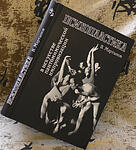

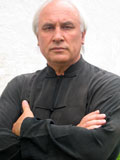 Коан – вопрос к членам Федерации Юн Чун Цюань от президента В.В. Мартынова: «Что Вы сделали для Федерации из того, что не мог бы сделать любой другой за деньги?»
Коан – вопрос к членам Федерации Юн Чун Цюань от президента В.В. Мартынова: «Что Вы сделали для Федерации из того, что не мог бы сделать любой другой за деньги?»
